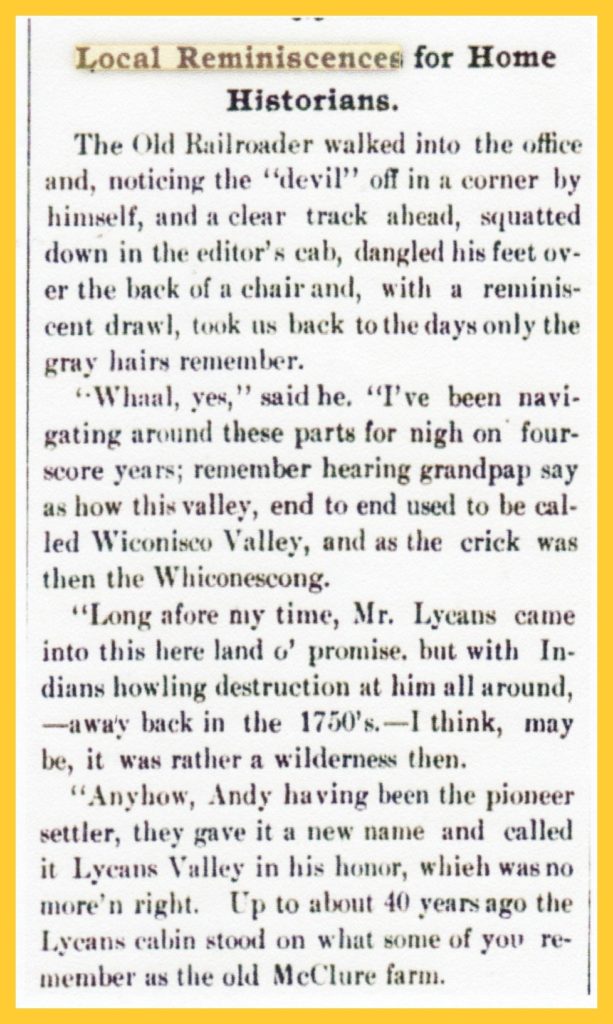First in a series of nine 1904-1905 newspaper articles in which two old-timers are portrayed reminiscing about the Lykens Valley of the past. The two fictional characters, the “old railroader” and the “patriarch,” wander into the offices of the Elizabethville Echo, Elizabethville, Dauphin County, Pennsylvania at different times and tell a concise, folksy history of the valley.
_____________________________________
Local Reminiscences for Home Historians
The Old Railroader walked into the office, and noticing the “devil” off in a corner by himself and a clear track ahead, squatted down in the editor’s cab, dangled his feet over the back of a chair and, with a reminiscent drawl, took us back to the days only gray hairs remember.
“Whaal, yes,” said he. “I’ve been navigating around these parts for nigh on four-score years; remember hearing grandpap say as how this valley, end to end used to be called Wiconisco Valley, and as the crick was then the Whiconescong.
“Long afore my time, Lycans came into this here land o’ promise, but with Indians howling destruction at him all around, – away back in the 1750’s – I think, may be, it was rather a wilderness then.
“Anyhow, Andy having been the pioneer settler, they gave it a new name and called it Lycans Valley in his honor, which was no more’n right. Up to about 40 years ago the Lycans cabin stood on what some of you remember as the old McClure farm.
“When Andy lived up there, the Indians had a village on Henry Bohner‘s farm, so grandpap said. By and by other settlers dropped in, and along about 1829 a Mr. Buchanan built Oak-Dale-Forge and a couple of houses there. Some of our old neighbors remember about that, and how the folks used to take turns bringing the mail up horseback from Millersburg. Talk about your Lykens Accommodation them days, heh!
“There are some houses here and there, but I recon as scarce as eggs at 30 cents. The first election was held up around Gratz and the first church was Hoffman’s.
“The, along about 1825 coal was found near the lower end of Short Mountain, and that settled in. That’s what settled the valley, I mean. That black dirt brought more yellow gold into the land o’ promise than I can calkerate, and while figgerin’ ain’t my trade, I can do some that ‘er sticklers.
“Well, they had to have a railroad, and John Paul, he marked it off for ’em, and they built it. Yes sir, 16 miles, horse power, flat strap rail, in 1834, – all aboard, and away she went. Simon Sallade was the director. The first coal over this road went by boat from Millersburg to Columbia.
“But railroads ain’t everlastin’ anymore than we are, and in a dozen year the Lykens Valley railroad was worn out. Yes sir, for three years where wasn’t a Pullman nor a dirt-truck up the valley, until by 1848, they fixed it up again with a T-rail and it’s bee a-going ever since. Laws! what d’you think we’d do if we had to do as grandpap did?
“And the Lykens Valley Railroad was the fourth in the whole country to haul hard coal. “Tain’s a running any lightning limiteds, o’course, and it don’t figger with any Northern Securities outrages, but it’s our prize accommodation, and we’re proud of it.”
At this juncture the “Devil” poked up the fire and the Old Railroader fled.
___________________________________
From the Elizabethville Echo, 15 December 1904.
Corrections and additional information should be added as comments to this post.
